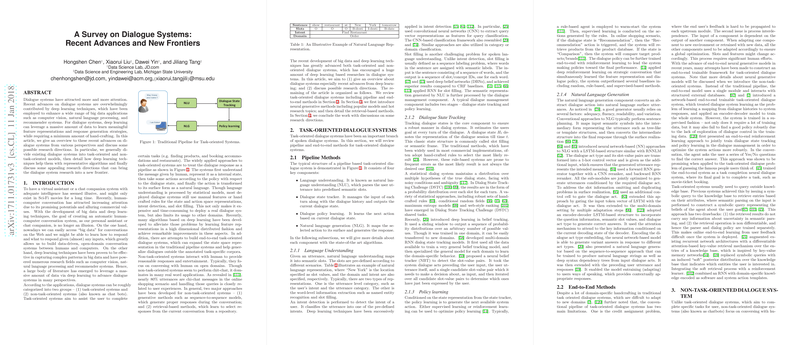Recent Advances in Dialogue Systems: A Survey and New Frontiers
This paper, authored by Hongshen Chen and colleagues, presents a comprehensive survey of recent developments in dialogue systems, with a specific focus on the application of deep learning (DL) techniques. These systems can be broadly divided into two categories: task-oriented and non-task-oriented (or chatbots). The paper provides a detailed analysis of how DL has been leveraged to enhance these systems, discussing task-specific methodologies as well as exploring the potential future trajectories in dialogue research.
Task-Oriented Dialogue Systems
Task-oriented systems aim to facilitate specific tasks such as product search or restaurant booking. Traditionally, these systems have relied on pipeline methods, which include components such as natural language understanding (NLU), dialogue state tracking, policy learning, and natural language generation (NLG). Despite their popularity, these systems often suffer from the limitations of handcrafted features, resulting in deployment challenges and domain constraints.
Recent DL advancements have led to the development of more sophisticated models that automatically learn high-dimensional representations and expand dialogue capabilities. Notable efforts include end-to-end trainable frameworks that unify various aspects of dialogue management, thereby bypassing the limitations of pipeline dependencies and enabling a seamless learning process across different domains.
Non-Task-Oriented Dialogue Systems
Non-task-oriented systems, or chatbots, are primarily focused on generating conversational dialogue in open domains. The dominant trend in this area has been the application of neural generative models, particularly Seq2Seq architectures with attention mechanisms. These models, while capable of generating fluent dialogue, often struggle with producing diverse responses and handling context over multiple turns. Research has addressed these issues through methods such as dialogue context incorporation, response diversity enhancement, and interactive learning from environments.
Additional advancements are informed by integrating personality traits, topic modeling, and external knowledge bases into the dialogue systems. Utilizing these elements can enrich interactions by providing responses that are both relevant and informative.
Implications and Future Directions
The paper highlights several key implications of these advancements. First, DL has indisputably blurred the lines between task-oriented and non-task-oriented systems, fostering an environment where a single model can potentially address multiple dialogue challenges. The integration of reinforcement learning within DL frameworks has shown promise in optimizing end-to-end dialogue management systems.
Looking forward, the authors propose several research directions:
- Swift Warm-Up: There is a need for mechanisms that can efficiently initialize dialogue systems in new domains, reducing dependency on extensive domain-specific datasets.
- Deep Understanding: Enhancing the system's ability to comprehend language and real-world interactions, potentially through leveraging large unstructured data sources and learning from human instruction.
- Privacy Protection: As systems become more pervasive, safeguarding user privacy while maintaining performance becomes crucial.
Conclusion
This survey comprehensively maps the landscape of recent dialogue system research, emphasizing the transformative role of deep learning. While significant progress has been made, particularly in terms of model sophistication and data utilization, challenges such as diverse response generation and efficient domain adaptation remain. The paper serves as a foundational reference for researchers intending to contribute to dialogue system innovation, with a clear set of future challenges identified to guide further exploration.
